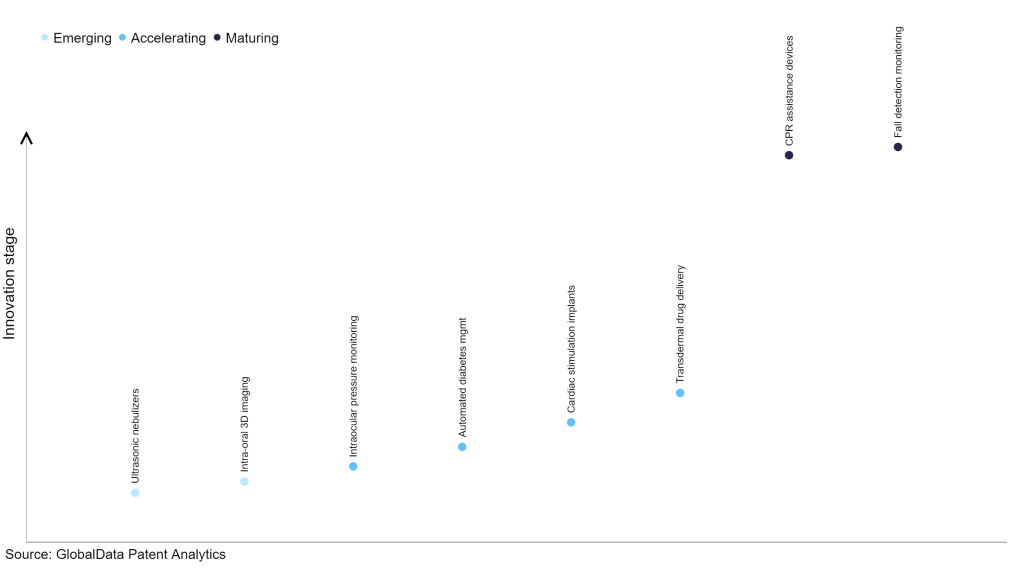The medical devices industry continues to be a hotbed of patent innovation. Activity is driven by increased need for homecare, preventative treatments, early diagnosis, reducing patient recovery times and improving outcomes, and growing importance of technologies such as machine learning, augmented reality, 5G and digitalization. In the last three years alone, there have been over 230,000 patents filed and granted in the medical devices industry, according to GlobalData’s report on Innovation in medical: targeted neurostimulation. Buy the report here.

Discover B2B Marketing That Performs
Combine business intelligence and editorial excellence to reach engaged professionals across 36 leading media platforms.
However, not all innovations are equal and nor do they follow a constant upward trend. Instead, their evolution takes the form of an S-shaped curve that reflects their typical lifecycle from early emergence to accelerating adoption, before finally stabilizing and reaching maturity.
Identifying where a particular innovation is on this journey, especially those that are in the emerging and accelerating stages, is essential for understanding their current level of adoption and the likely future trajectory and impact they will have.
35+ innovations will shape the medical devices industry
According to GlobalData’s Technology Foresights, which plots the S-curve for the medical devices industry using innovation intensity models built on over 165,000 patents, there are 35+ innovation areas that will shape the future of the industry.
Within the emerging innovation stage, ultrasonic nebulizers and intra-oral 3D imaging are disruptive technologies that are in the early stages of application and should be tracked closely. Automated diabetes management, cardiac stimulation implants, and transdermal drug delivery are some of the accelerating innovation areas, where adoption has been steadily increasing. Among maturing innovation areas is CPR assistance devices and fall detection monitoring, which is now well established in the industry.
Innovation S-curve for the medical devices industry

Targeted neurostimulation is a key innovation area in medical devices
Targeted neurostimulation is a method of providing specific stimulation to target nerves or tissues to achieve a therapeutic or cosmetic effect. The stimulation can be delivered using various forms of energy such as electrical, ultrasonic, thermal or electromagnetic waves, and can be applied to areas such as the face, eyes, vaginal tissue, or joints to modulate nerve signals or cellular function.
GlobalData’s analysis also uncovers the companies at the forefront of each innovation area and assesses the potential reach and impact of their patenting activity across different applications and geographies. According to GlobalData, there are 135+ companies, spanning technology vendors, established medical devices companies, and up-and-coming start-ups engaged in the development and application of targeted neurostimulation.
Key players in targeted neurostimulation – a disruptive innovation in the medical devices industry
‘Application diversity’ measures the number of applications identified for each patent. It broadly splits companies into either ‘niche’ or ‘diversified’ innovators.
‘Geographic reach’ refers to the number of countries each patent is registered in. It reflects the breadth of geographic application intended, ranging from ‘global’ to ‘local’.
Medtronic and Merz Pharma are two of the leading patent filers in targeted neurostimulation devices. Some other key patent filers in this field include Boston Scientific, Highland Instruments, and Koninklijke Philips.
In terms of application diversity, Pharosgen leads the pack, while The Invention Science Fund II and Amorepacific Group stood in the second and third positions, respectively. By means of geographic reach, ElectroCore held the top position, followed by Thermalin and CareWear.
Targeted neurostimulation, with its ability to directly access the central nervous system, promises to be a game-changer. Its precision, reduced side effects, and improved patient adherence will drive its popularity. Advanced techniques and emerging technologies, such as artificial intelligence and enhanced connectivity, will expand its role in revolutionizing the treatment of neurological and psychiatric disorders.
To further understand the key themes and technologies disrupting the medical devices industry, access GlobalData’s latest thematic research report on Medical Devices.
Data Insights
From

The gold standard of business intelligence.
Blending expert knowledge with cutting-edge technology, GlobalData’s unrivalled proprietary data will enable you to decode what’s happening in your market. You can make better informed decisions and gain a future-proof advantage over your competitors.




